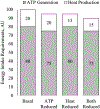Impact of calorie restriction on energy metabolism in humans
- PMID: 32057825
- PMCID: PMC9036397
- DOI: 10.1016/j.exger.2020.110875
Impact of calorie restriction on energy metabolism in humans
Abstract
Calorie restriction (CR) is the most potent, non-pharmacological intervention to support metabolic health. The effects of calorie restriction exceed weight loss. Consistent throughout many studies, calorie restriction induces a reduction in energy expenditure that is larger than the loss of metabolic mass, i.e. fat-free mass and fat mass, can explain. Per prevailing theories of mammalian aging, this disproportionate reduction in metabolic rate, defined as metabolic adaptation, reduces oxidative damage and thereby delays age-associated declines in physiological function. The aim of this narrative review is to investigate the origins of CR-induced metabolic adaptation. From a physiological standpoint this likely relates to the composition of body weight loss, reductions in insulin secretion, thyroid and leptin concentrations, and increased mitochondrial energy efficiency. Behavioral factors including physical activity and eating behaviors likely also play a role, specifically to prevent weight regain. Future studies are required to understand the interindividual differences in the response to CR, e.g. by sex, physical activity, or mitochondrial capacity, and to assess the long-term implications of CR for weight regain.
Keywords: Adaptive thermogenesis; Calorie restriction; Energy efficiency; Energy requirements; Weight loss; Weight regain.
Copyright © 2020 Elsevier Inc. All rights reserved.
Conflict of interest statement
Declaration of competing interest None. The funding source was not involved in writing of this manuscript.
Figures


References
-
- Blundell JE, Caudwell P, Gibbons C, Hopkins M, Naslund E, King NA, Finlayson G, 2012. Body composition and appetite: fat-free mass (but not fat mass or BMI) is positively associated with self-determined meal size and daily energy intake in humans. Br. J. Nutr 107, 445–449. - PubMed
-
- Booth FW, Laye MJ, Roberts MD, 2011. Lifetime sedentary living accelerates some aspects of secondary aging. J Appl Physiol (1985) 111, 1497–1504. - PubMed
-
- Bosy-Westphal A, Kossel E, Goele K, Later W, Hitze B, Settler U, Heller M, Gluer CC, Heymsfield SB, Muller MJ, 2009. Contribution of individual organ mass loss to weight loss-associated decline in resting energy expenditure. Am. J. Clin. Nutr 90, 993–1001. - PubMed
Publication types
MeSH terms
Grants and funding
LinkOut - more resources
Full Text Sources
Medical

